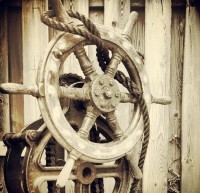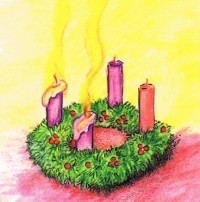Catholic Culture Moments
And Candles Light the Way
I don’t know too many people who can profess to going into a Catholic church that had no candles in it. Candles have been part of the Church’s liturgy since about the 8th century.
Where did this practice come from? Well, we can’t ignore the fact that incense, music, candles, flowers, etc. were part of the mystical settings of pagan worship, however, once the Church began to formalize liturgically she took these practices as her own and gave them Holy symbolism.
Candles used for liturgical worship are, for mystical reasons, to be made of bees wax. Pure bees wax is the symbol of the pure flesh Christ received from His Virgin Mother, the wick signifies the Soul of Christ, and the flame signifies His divinity. These were obviously not the intentions of the pagan world! Here is an interesting fact; in 1850 the Church allowed an exception to bees wax for missionaries in Oceana. Because they were unable to attain bees wax they were permitted to use sperm-whale candles! (New Advent Catholic Encyclopedia)
Candles are required on the altar during Holy Mass but the number will not always be the same. The altar should have at least two in any celebration, four or six is permissible especially on Sundays and Holy Days of obligation. If the Diocesan Bishop is celebrating Mass then seven is the required number (GIRM 117).
February 2 is Candlemas Day. This is the feast day of the presentation of Jesus in the temple. On that day there is often a candle blessing with prayers, incense, hymns, and a procession. Once the candles are blessed they are given to the laity for devotional use. (New Advent Catholic Encyclopedia)
Candles are commonly used for devotions to saints. An interesting medieval practice was the faithful offering a candle or number of candles at a shrine equaling the height measurement of the person for whom the favor was asked. This was called “measuring to” whichever saint was being regarded for prayer. (New Advent Catholic Encyclopedia)
And A Ship to Sail Her By
Identifying objects for families, communities, countries, etc. are important in the expression of that group. Family crests, community icons, country’s flags and the like go far to identify these bands. The Church is no different; she has many symbols that allow her to be identified by those both in and out of the association. One such symbol from antiquity is the ship. This symbolizes the Church being tossed around in the sea of worldliness, persecution, and disbelief and delivered safely to the other side in holiness. The biblical accounts of Noah and the Ark, and Christ calming Peter’s boat aid in this imagery. Also, there was a time when Christians needed to hide symbols identifying them and a ship’s mast served as a cross.
In the Apostolic Constitutions book II the bishop, surrounded by the faithful, is compared to the helmsman of a ship. Clement of Alexandria who lived between 150 and 215 AD approved the ship to be used as a signet because it was a Christian symbol even then; and let our seals be either a dove, or a fish, or a ship scudding before the wind . . . (New Advent Encyclopedia).
The inside of the church is called the nave, Latin navis, meaning ship. The nave being the place where the faithful are gathered is separated by steps from the sanctuary, which is sometimes considered the helm of the boat with the helmsman being the priest or bishop celebrating Holy Mass in persona Christi.
There are a number of Saints whose symbol is a ship because they provided a figurative boat to help save the faithful from drowning in the seas of worldly sin. Two such saints are St. Ursula and St. Jude. Finally, for this commentary, the leadership of the Holy Father is often considered to be guiding the Barque (Bark) of St. Peter. Now when you see a statue, emblem, or stained glass in a church with a ship you will know that it has deep rooted Christian symbolism.
Below are three Saints that have nautical patronage:
St. Nicholas: In parts of the world, St. Nicholas' chief patronage is that of sailors and ships—offering safe voyage and protection from storms. In some places sailors, instead of wishing one another luck, say, "May St. Nicholas hold the tiller."
St. Brendan: Born in ancient Ireland, he became a priest in 512 AD. St. Brendan developed monasteries in Ireland and eventually took a group of monks on a voyage from Ireland across the Atlantic Ocean in search of the Garden of Eden. He is the patron of sailors and navigators.
Stella Maris (The Star of the Sea): Has long been the favorite title by which people of the sea have called on her in whose protection they have always trusted: the Blessed Virgin Mary. Her son, Jesus Christ, accompanied his disciples in their vessels, helped them in their work and calmed the storms. And so the Church accompanies seafarers, caring for the special spiritual needs of those who for various reasons live and work in the maritime world. Pope St. JP II
The Symbols of Advent
If someone were to ask you to explain the symbols of Advent and what they mean, could you? The symbols are the very things that help lead us to the Nativity. Amid the hustle and bustle of gift preparations and parties with friends and family, the symbols of the season help to keep us grounded in the truth behind the coming Christmas day.
One of the most well known symbols is the Advent wreath. This symbol is fairly new to the United States, becoming popular and traditional during the 1930’s. The Advent wreath actually began with the Lutherans of East Germany in the 16th century. Latin Rite Catholics in Germany seem to have adopted the practice in the 1920’s and brought it with them to the United States. The wreath more than likely has its roots in the light symbols used at the end of November and beginning of December in medieval folklore.
The Advent wreath is made of some sort of evergreen traditionally symbolizing eternal life, and four candles; three violet and one rose colored for each week of Advent. Although popular these colors are not universal. The candles used by Germans, including Pope Benedict VXI are actually red. Fr. Francis X. Weiser, SJ, in his book Handbook of Christian Feasts and Customs explains the traditional symbolism of the Advent wreath reminds the faithful of the Old Testament, when humanity was "sitting in the darkness and in the shadow of death" (Luke 2:79); when the prophets, illumined by God, announced the Redeemer; and when the hearts of men glowed with the desire for the Messiah. The wreath -- an ancient symbol of victory and glory -- symbolizes the "fulfillment of time" in the coming of Christ and the glory of His birth. There are a number of other symbolic connections floating around out there, each leading us to the birth of Christ.
The Advent wreath unites us historically with Israel, who in the Old Testament awaited with great anticipation the coming of the Messiah who would set them free. Isn’t that what we are doing, anticipating the birth and return of the Messiah, the Sacred One? The wreath allows us to see how close we are getting, at least to His nativity and pray for our own readiness.
This devotion doesn’t need to end on Christmas Eve. Many people continue to burn those candles down but add a large white Christ candle to the center of the wreath to be lit beginning December 24. Burning this wreath all through the Christmas season until the Epiphany or even the baptism of Christ is a great reminder that He is the reason for Advent.


